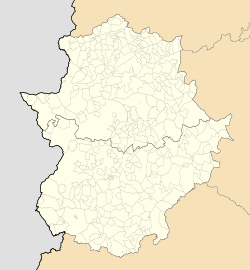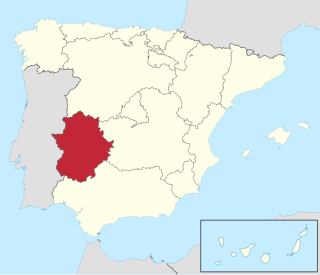
Extremadura is a landlocked autonomous community of Spain. Its capital city is Mérida, and its largest city is Badajoz. Located in the central-western part of the Iberian Peninsula, it is crossed from east to west by the Tagus and Guadiana rivers. The autonomous community is formed by the two largest provinces of Spain: Cáceres and Badajoz. Extremadura is bordered by Portugal to the west and by the autonomous communities of Castile and León (north), Castilla–La Mancha (east), and Andalusia (south).

The province of Badajoz is a province of western Spain located in the autonomous community of Extremadura. It was formed in 1833. It is bordered by the provinces of Cáceres in the north, Toledo, Ciudad Real in the east, Córdoba in the south-east, Seville, and Huelva in the south and Portugal in the west.

Moriscos were former Muslims and their descendants whom the Catholic Church and Habsburg Spain commanded to forcibly convert to Christianity or face compulsory exile after Spain outlawed Islam. Spain had a sizeable Muslim population, the mudéjars, in the early 16th century.
Azuaga is a town located in the province of Badajoz in southern Extremadura, bordering the Andalusian provinces of Seville and Córdoba in Spain. Azuga is 140 km from Badajoz, 125 km from Córdoba, and 140 km from Seville, in the foothills of Sierra Morena in the frontier region of Campiña Sur.

Trujillo is a municipality located in Extremadura, an autonomous community of Spain in the Province of Cáceres. In 2013 the municipality had 9,086 inhabitants. Originally settled on a granite knoll, which was readily fortified, the town now extends to the southeast of its original site. Trujillo is both a centre for tourism, with more than 25 hotels, and a regional market town.

Monfragüe is a Spanish national park noted for its bird-life. It is situated in the center of a triangle formed by Plasencia, Trujillo and the city of Cáceres within the province of Cáceres. Monfragüe is also a comarca of Extremadura, western Spain.

Motril is a town and municipality located on the Mediterranean coast of Granada, Spain. It is the second largest town in the province, with a population of 60,368 as of 2016. Motril is located near the Guadalfeo River and is 69 km (43 mi) from Granada.
Villanueva de la Serena is a city in the Province of Badajoz, Extremadura, Spain. It has a population of 26,111 (2010) and forms part of a larger urban area with the neighbouring town of Don Benito.

Guijo de Santa Bárbara is a municipality located in the province of Cáceres, Extremadura, Spain. According to the 2005 census (INE), the municipality has a population of 429 inhabitants.
Calera de León is a municipality located in the province of Badajoz, Extremadura, Spain. According to the 2008 census (INE), the municipality has a population of 1,070 inhabitants.
Cordobilla de Lácara is a municipality located in the province of Badajoz, Extremadura, Spain. According to the 2005 census (INE), the municipality has a population of 1023 inhabitants.
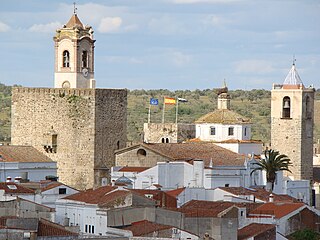
Fregenal de la Sierra is a municipality located in the province of Badajoz, Extremadura, Spain.
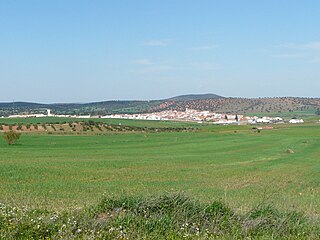
Retamal de Llerena is a municipality located in the province of Badajoz, Extremadura, Spain. According to the 2008 census (INE), it has a population of 497 people.
Llera is a Spanish municipality in the province of Badajoz, Extremadura, western Spain. According to the 2014 census, the municipality has a population of 905 inhabitants.

Sierra Suroeste is a comarca located in southwestern province of Badajoz in the autonomous community of Extremadura, western Spain. Its capital and largest city is Jerez de los Caballeros.

The Republic of Salé, also known as the Bou Regreg Republic and the Republic of the Two Banks, was a city-state maritime corsair republic based at Salé in Morocco during the 17th century, located at the mouth of the Bou Regreg river. It was founded by Moriscos from the town of Hornachos, in western Spain. The Moriscos were the descendants of Muslims who were nominally converted to Christianity, and were subject to mass deportation during Philip III's reign, following the expulsion of the Moriscos decrees. The republic's main commercial activities were the Barbary slave trade and piracy during its brief existence in the 17th century.
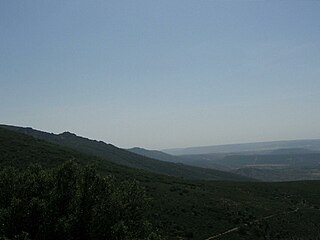
The Montes de Toledo is one of the main systems of mountain ranges in the Iberian Peninsula. They divide the drainage basin of the Tagus from the basin of the Guadiana. The highest peak is La Villuerca, which is 1,603 m (5,259 ft) high.

Aguilar del Río Alhama is a village in the province and autonomous community of La Rioja, Spain. The municipality covers an area of 54.11 square kilometres (20.89 sq mi) and as of 2011 had a population of 549 people. It is located in a low altitude mountainous area, in the foothills of the Iberian System. It belongs to the region of Rioja Baja and is washed by the waters of the Alhama river.

Tierra de Barros is a comarca in the province of Badajoz, Extremadura, Spain. Its capital and administrative center is Almendralejo. The comarca contains 15 municipalities and 74,872 inhabitants.
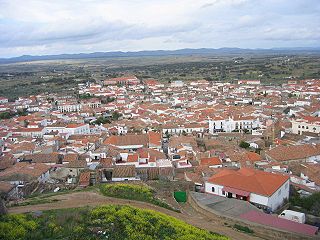
Sierra de San Pedro is a mountain range in the greater Montes de Toledo range, Spain. It is named after Saint Peter the apostle and rises in the limits of Cáceres and Badajoz Provinces, in the western part of the autonomous community of Extremadura close to its border with Portugal. This range gives its name to the Sierra de San Pedro - Los Baldíos comarca.


